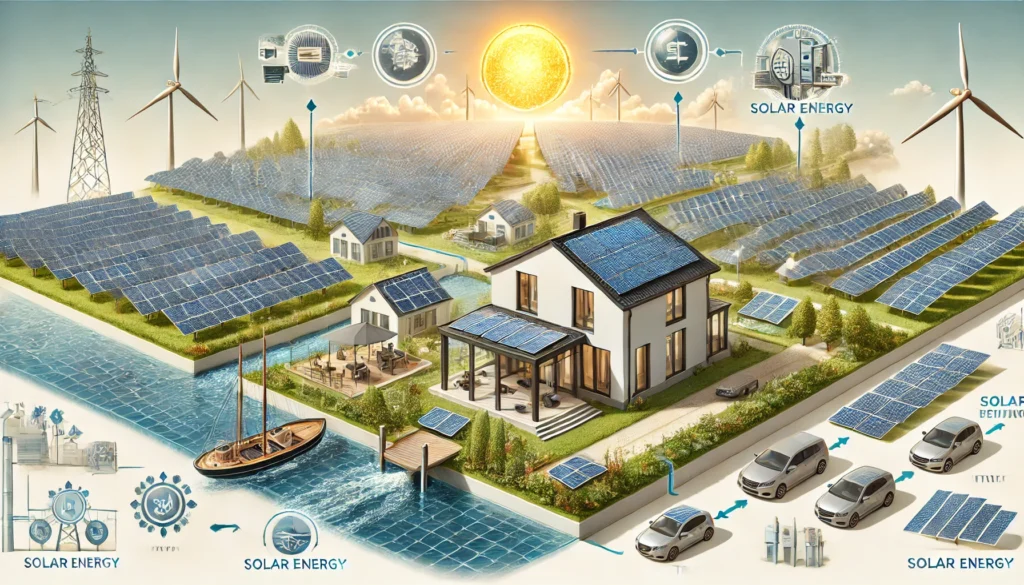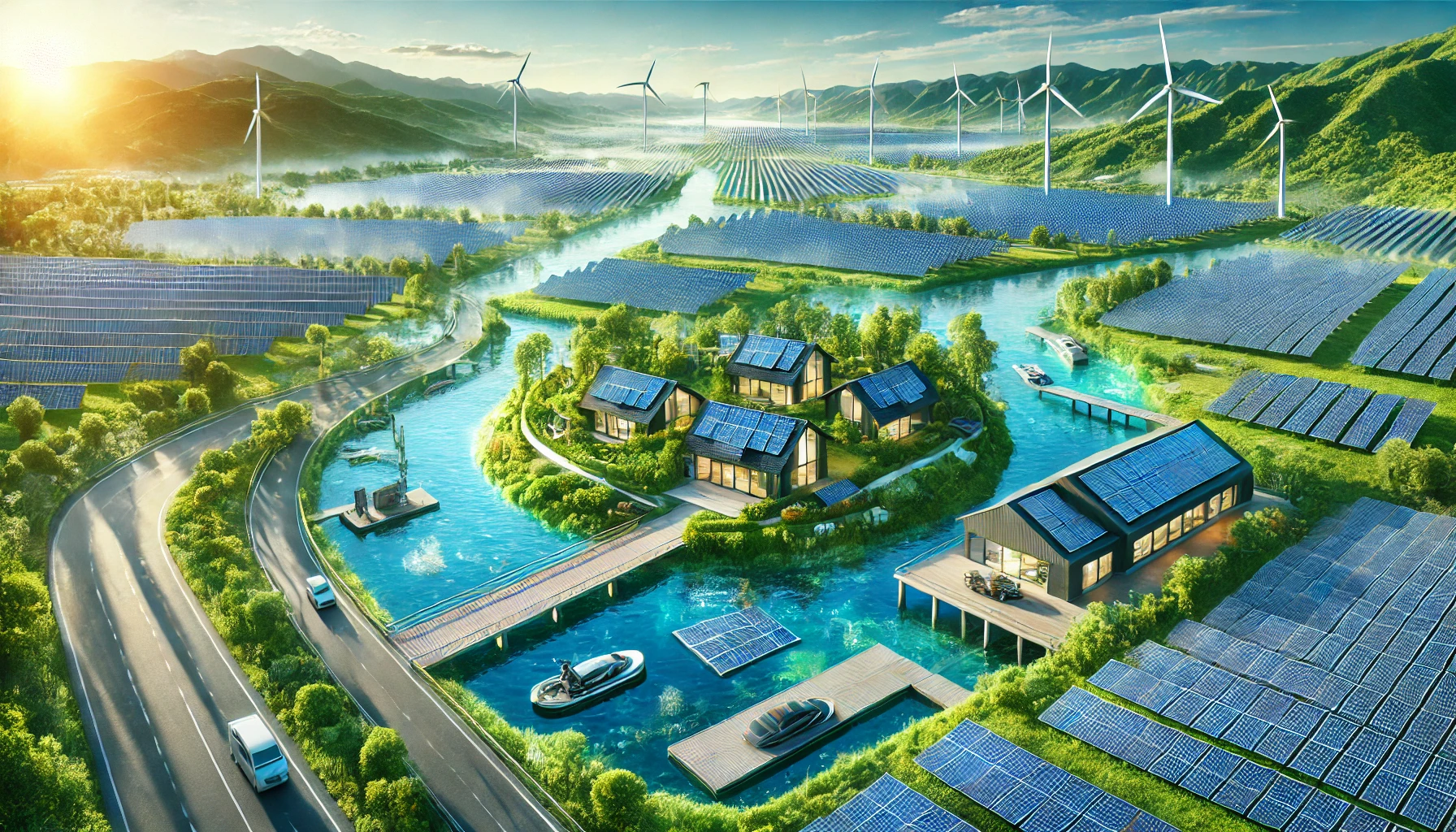What Is Green Solar Energy?
Solar energy harnesses sunlight to generate electricity without relying on fossil fuels, making it a renewable and environmentally sustainable energy source. This method of energy production helps reduce our dependence on non-renewable resources, ultimately contributing to a cleaner, greener planet.
Importance of Solar Energy in Combatting Climate Change
Solar energy plays a crucial role in mitigating climate change by reducing greenhouse gas emissions. By replacing fossil fuels with clean, renewable solar power, it helps combat global warming, conserves natural resources, and provides a sustainable solution to the climate crisis.
Solar solutions not only help the environment but also offer green energy independence for homes, businesses, and communities, reducing electricity costs and ensuring a more resilient energy future.
Understanding Solar Energy

How Solar Energy Works
Solar panels use photovoltaic (PV) cells to convert sunlight into electricity, which can then power homes, businesses, and large facilities. This process generates clean energy without emitting harmful pollutants, making it an environmentally friendly power source.
Benefits of Solar Energy
- Environmental Benefits: Solar energy reduces ecological degradation and helps conserve natural resources, playing a key role in fighting climate change.
- Cost Savings: Installing solar panels can significantly reduce electricity bills over time, providing long-term financial savings for users.
- Energy Independence: Solar systems offer a reliable, renewable power source that is independent of traditional power grids, increasing energy security and reducing reliance on fossil fuels.
- Residential Solar Solutions: Residential solar systems provide a consistent, renewable power source, offsetting electricity costs and boosting property values for homeowners.
Commercial and Industrial Solar Panels
- Cost-Effective Operations: Solar installations help businesses reduce operational costs and improve energy efficiency by generating large amounts of electricity.
- Solar Farms: Large-scale solar farms supply renewable energy to cities and contribute significantly to national and regional energy grids.
Portable Solar Solutions
Portable solar chargers and panels are convenient and versatile, making them ideal for outdoor activities, travel, or emergency energy needs.
Community Solar Projects
Community solar projects provide shared access to solar power, making renewable energy more accessible in urban areas where space for individual panels may be limited.
Key Components of a Solar Energy System
- Solar Panels: The core component of any green solar energy system, with various types available, including monocrystalline, polycrystalline, and thin-film panels.
- Inverters: Inverters convert the direct current (DC) electricity generated by solar panels into alternating current (AC), which is usable by home appliances and businesses.
- Battery Storage Systems: Solar batteries store excess energy for use during cloudy days or at night, ensuring continuous power availability.
- Mounting Structures: Solar panels need mounting structures such as roof mounts, ground mounts, and tracking systems to optimize energy collection.
- Monitoring and Maintenance Tools: Monitoring tools track system performance, helping detect issues early and ensuring the solar system operates efficiently over its lifespan.
Technological Advancements in Solar Energy
- Bifacial Panels: These panels capture sunlight on both sides, increasing energy output without taking up extra space.
- Solar Roof Tiles: Solar roof tiles seamlessly integrate into traditional roofing materials, offering both aesthetic appeal and efficient solar power generation.
- Artificial Intelligence in Solar Monitoring: AI tools enhance solar energy management by optimizing system performance and anticipating maintenance needs.
- Battery Storage Innovations: New battery technologies, like lithium-ion, provide greater storage capacity and longer system lifespans.
Environmental Benefits of Green Solar Energy
- Reducing Carbon Emissions: Solar energy helps replace fossil fuels, significantly reducing carbon dioxide emissions and mitigating global warming.
- Preserving Natural Resources: Solar energy reduces our dependence on finite resources like coal, contributing to the preservation of Earth’s natural resources for future generations.
- Improved Air Quality: By decreasing reliance on fossil fuels, solar energy helps reduce air pollution, leading to cleaner air and better public health.
Financial Incentives for Going Solar
- Tax Credits and Rebates: Governments offer financial incentives like tax credits and rebates, making solar power more affordable and accessible.
- Solar Renewable Energy Certificates (SRECs): Homeowners can sell their excess solar energy as certificates, creating an additional income stream while promoting renewable energy.
- Net Metering: Net metering allows solar system owners to send excess energy back to the grid in exchange for credits, further reducing electricity bills.
- Government Grants and Subsidies: Various grants and subsidies help cover installation costs, making it easier for more people to adopt solar energy.
Adopting Solar Energy
Initial Installation Costs
While the initial investment for solar systems can be significant, the long-term savings on electricity bills often make it a financially worthwhile decision.
Space Requirements
Solar panels require adequate space for installation. Roofs and open land are ideal, but space constraints in urban environments may pose challenges.
Weather and Storage Considerations
Solar energy production depends on sunlight, so cloudy or rainy conditions can reduce output. Efficient storage solutions, like batteries, help ensure consistent power supply even when the sun isn’t shining.
Integration Issues
Integrating solar power into existing energy grids can be complex. Advanced technologies and supportive policies are needed to ensure smooth integration.
Steps for Implementing Green Solar Energy Solutions
- Assess Your Energy Needs: Begin by evaluating your energy consumption to determine the appropriate system size for your home or business. This ensures a cost-effective installation.
- Select the Right Solar Provider: Choose a solar provider with a proven track record of quality service and affordable pricing. Compare options to find the best fit for your needs.
- Professional Installation: Professional installation ensures that your solar system is set up optimally, maximizing efficiency and energy output.
- Ongoing Maintenance and Monitoring: Regular maintenance and monitoring tools help ensure that your solar system continues to perform at its best over time.
Solar Energy Around the World
Countries like China, Germany, and the United States lead in solar energy adoption, making large investments to push renewable energy forward.
Emerging markets are rapidly adopting solar technologies, taking advantage of improved solar technologies and cost reductions.
Case Studies of Successful Solar Projects
Projects like India’s Bhadla Solar Park, one of the largest solar parks in the world, serve as inspiring examples of how large-scale solar solutions can make a significant impact on national energy grids.
Solar Energy’s Growing Role
Solar energy is projected to continue growing as an essential component of the global energy mix, driven by its affordability, sustainability, and the increasing adoption of renewable technologies.
Integration With Other Renewable Sources
Solar power works well alongside other renewable sources like wind and hydroelectric energy, creating more reliable and resilient energy systems.
Impact of Policies on Solar Expansion
Government policies, such as subsidies, tax incentives, and regulations, are crucial in promoting solar adoption and accelerating the transition to renewable energy.
How to Select the Appropriate Solar Solutions
- Evaluate Energy Goals: Consider your energy needs and long-term sustainability goals to select the solar system that best aligns with your objectives.
- Budget Considerations: Assess the costs and savings involved in solar adoption. Look for budget-friendly solutions that balance quality with long-term performance.
- Long-Term Sustainability: Choose solar systems that are durable and capable of delivering consistent performance over their lifespan, supporting long-term environmental and financial goals.
Conclusion: The Future of Green Solar Energy
Green solar energy offers numerous benefits for individuals, businesses, and communities. It not only reduces carbon emissions but also provides an investment in a cleaner, more sustainable future. Whether you’re taking small steps or making a significant commitment, every move toward solar energy helps make a difference in building a greener world.
Frequently Asked Questions (FAQs)
- What types of solar panels are there?
- The most common types are monocrystalline, polycrystalline, and thin-film panels, each offering different levels of efficiency and cost-effectiveness.
- How long do solar panels typically last with proper maintenance?
- Solar panels generally last 25-30 years with proper care and maintenance.
- Can solar energy power my entire home?
- Yes, solar systems can power an entire household. With battery storage, solar energy can provide reliable power even during cloudy days or at night.
- What happens with excess solar energy generated?
- Excess energy can be stored in batteries or sent back to the grid, where it may be credited through net metering programs.
- Are there any risks when utilizing solar energy?
- Solar energy systems are generally safe, but issues like system malfunctions or poor installations can pose risks. Professional installation and maintenance help minimize these risks.

